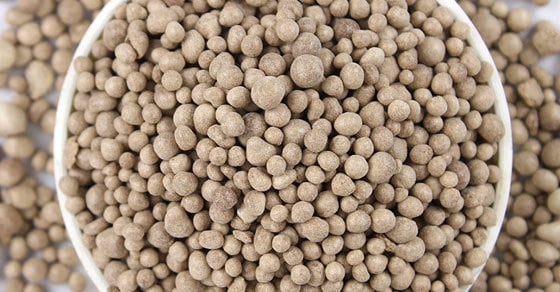Plant biostimulants represent a relatively new category of products used in crop production to improve plant growth through various biological mechanisms. This category emerged in recent years and continues to grow at a rapid pace; Fortune Business Insights predicts the biostimulant market will see a CAGR of 11.43% between 2022 and 2029.
As fertilizer producers look to incorporate these vital materials into their products, granulation looks to be an important tool in bringing them to market. As a preferred provider to fertilizer producers everywhere, FEECO remains a comprehensive resource in aiding these efforts through process development services and custom fertilizer granulation equipment.
What are Plant Biostimulants?
While a formal definition and standards for plant biostimulants have yet to be agreed upon, there is a general consensus that they cover a wide range of materials that, when applied to seed, plant, or soil, cause physiological changes that can improve plant growth and response to stress. This may be carried out through various modes of action.
Plant biostimulants can be sourced from a range of materials, which may include:
- Bacterial or microbial inoculants
- Biochemical materials
- Amino acids
- Humic acids
- Fulvic acids
- Seaweed extracts
- Protein hydrolysates
- Complex organic materials
- Beneficial chemical elements
- Inorganic salts
- Chitin and chitosan derivatives
Biostimulants are not pesticides or fertilizers.
Why are plant biostimulants important?
Rising pressure to produce higher yields on fewer acres of arable land while mitigating environmental risks has put nutrient management and nutrient use efficiency (NUE) in the spotlight.
Biostimulants are a natural fit for sustainable crop production efforts, with a growing body of research and applications illustrating their effectiveness. Biostimulants hold the potential to accomplish a number of important objectives that ultimately contribute to higher yields, without risking environmental quality:
- Improving nutrient uptake
- Enhancing nutrient use efficiency (NUE)
- Helping plants defend against abiotic stressors
- Increasing crop quality
They have also proven to offer a powerful synergy when combined with micronutrients.
While micronutrients are recognized for their own important contributions to crop growth, when combined with biostimulants, the benefits appear to be two-fold, according to a recent study. The study, conducted by Nottingham Trent University in collaboration with Micromix found that the hybrid approach increased drought tolerance in plants by 25% to 35%, while also improving yield by 30%.
Activity in the sector has been on the rise. Recently, Congressmen Jimmy Panetta (D-CA) and Jim Baird (R-IN) introduced the Plant Biostimulant Act of 2022, aimed at establishing a national definition and barring the category from regulation under the Federal Insecticide, Fungicide, and Rodenticide Act (FIFRA), as biostimulants are not pesticides.
In a statement, the Biological Products Industry Alliance (BPIA) lauded the bipartisan bill’s introduction as important progress, with Executive Director Keith Jones stating: “Plant biostimulant products can increase the uptake and utilization of existing and applied nutrients, thus reducing the potential for nutrient runoff into rivers, lakes, and streams or loss to the atmosphere as greenhouse gasses.”
The Fertilizer Institute (TFI) also recently teamed up with the U.S. Biostimulant Coalition to form a Biostimulant Council aimed at accomplishing several goals, including building awareness around biostimulants, increasing commercial and technical understanding, collaborating with other groups, and forging a clear path for the industry.
As fertilizer producers gain a greater understanding of this essential new tool, many of them are looking to incorporate them into their product lines, and for this, the wet granulation process offers significant opportunity.
Using Granulation to Facilitate Biostimulant Use
As with many specialty fertilizers and soil amendments that incorporate various traditional and novel materials, the wet granulation approach is an effective way of incorporating biostimulants into a saleable product.
The flexibility of the granulation process allows for the inclusion of nutrients and beneficial additives, whether in solid or liquid form. As a result, producers have the option to include their biostimulant into a fertilizer product in whatever form it might exist. However, it should be noted that wet granulation does require a drying step, which may not be suitable in situations where high temperatures could pasteurize biological components.
This approach to granular fertilizer production brings all of the components together so that each and every granule contains the entire formulation (i.e., a complex fertilizer).
In addition to the production of a premium complex fertilizer, granulation facilitates another valuable way to incorporate biostimulants into a granular fertilizer product, through coating.
Coating Granular Fertilizers With Biostimulants
A granular product produced via wet granulation is the ideal substrate for coating, which many producers have found to be an effective way of incorporating biostimulants into the product lines.
The round granules yielded by wet granulation promote uniform coating, particularly when carried out in a coating drum, which uses a spray system and agitation to evenly distribute a coating among a bed of material.
Process Development for the Incorporation of Biostimulants in Granular Fertilizers
One critical advantage FEECO offers to producers looking to incorporate biostimulants into their fertilizer products is our feasibility testing and process development facility, the Innovation Center.
The Innovation Center offers batch- and pilot-scale testing on a variety of granulation equipment. This allows fertilizer producers to confirm proof of concept, as well as establish the process and equipment criteria necessary to produce their product to the desired specifications. Coating can also be tested.
FEECO can also help to ensure that granules meet the rigorous physical specifications required by the fertilizer market.
The data gathered during testing is then used to engineer commercial-scale equipment.
Conclusion
Biostimulants are an exploding market that will only continue to grow in the coming years. As fertilizer producers look to incorporate these vital materials into their granular fertilizer products, FEECO is an essential partner in bringing these products to market through unmatched process development services and custom granulation equipment and systems. To learn more about how we can help you, contact us today!


